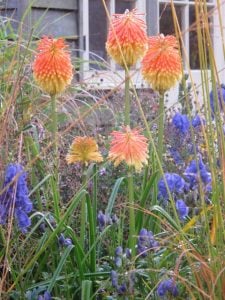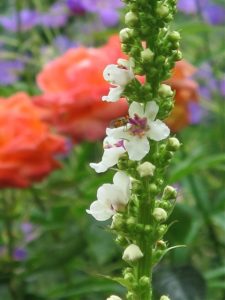Colour is such a personal thing and most of us have a favourite. Mine of course is orange and it’s the choice of an exuberant Leo lady. You see I was born on the hottest day of the year, in July, and my mother never let me forget it. I’m unusual I know, for orange is the bête noire of many a gardener. However I think it radiates warmth and it’s the best touch-paper colour for blues and purples. So I’m all for it, fashionable or not.

At the moment I’m enjoying a wonderful show from a yellow-orange red hot poker, a species called K. rooperi. It’s settled in here, although it’s not got a great reputation for enduring in cold gardens – which mine is. I have two clumps and the best one is currently showing nine flowers, the best display so far. The triangular heads glow in autumn light, which is crystal clear due to the evenly balanced days and nights. It appears in October, flattering the rich-blue aconitum ‘Arendsii’ and the buttermilk silky plumes of a variegated short pampas grass called Cortaderia selloana ‘Silver Feather’. All three are invaluable late additions, but ‘Silver Feather’ is hard to find.
The light in summer is no where near as flattering as autumn light, especially here. My garden roosts in the high Cotswolds, on a level plateau, so in summer we get overhead glare that washes out colours. It’s an ugly, hard light so the one colour I positively avoid is virginal white. It looks glacial in brash overhead summer sun, so all my pure-white flowers (such as Viola cornuta ‘Alba, Silene fimbriata and Lamium orvala ‘Album’) are May-flowering ones tucked up in my woodland garden. Their cool presence adds a bit of extra light to a gloomy area underneath a giant whitebeam, colonised by arborescent ivy.
Roses major here and the late Peter Beales, a man who knew roses better than almost anyone, was a friend of mine. We shared a passion for roses, particularly those that flower just the once in June. These are the ones that drip with flower and make June glorious and he preferred them to repeat-flowering roses for this reason. Peter’s favourite was ‘Great Maiden’s Blush’ a rose he remembers seeing from his pram. My once and only is probably ‘Goldfinch’ an apricot rambler that fades to cream. I also grow a climbing rose called ‘Pippin’, a healthy warm-pink named after him. As a child Peter Beales had ruddy cheeks the colour of Orange Pippin apples, so it was the family’s pet name for him.
Peter and I were once in a garden together on a sunny June day, I know not where, when we stumbled upon the white rose ‘Mme Hardy’ and we both reeled away from it. It’s green eye hinted at jealousy, according to Peter, and we both remarked at how difficult it was to place. Think back to the Dulux advert, with the shaggy sheepdog if you can, and those cans of brilliant white and then think of their softer shades such as blossom white, almond white and violet white instead. These blends appear white, but the hint of colour stops them looking harsh. Brilliant white walls give you headaches.
That’s the reason that my repeat-flowering summer roses come in softer shades that look warm-white under summer sun. They include the floribunda rose ‘Champagne Moment’, a wonderful Kordes-bred rose that never succumbs to disease. You could equally well use the Hybrid Musks ‘Penelope’, or the warmer apricot-toned ‘Buff Beauty’, although both need space. Pale-pinks in my summer borders include the David Austin roses ‘Wildeve’ and ‘Olivia Rose Austin’, both superb to cut, along with a peachier floribunda rose ‘Joie de Vivre’. I also rate ‘Pearl Drift’.
Floribundas are full of flower and tend to produce clusters of roses on lowish-growing bushes, but the rose trade tell me it’s an unpopular name with customers. You rarely see it on websites now. Floribunda is usually replaced by shrub rose, which is a shame because they are certainly not in that category. The same garden snobbery, which says orange is common and dahlias are vulgar, is obviously alive and well in the rose garden too. A posh French name and a long history do not always make a good rose, despite what some say. Give me disease-free every time and many modern roses have flowers that look like old-fashioned roses.
In my cutting garden there are two more warm-white, soft-toned roses and these have been bred by Harkness Roses. They are ‘Chandos Beauty’, the favourite rose of household icon Mary Berry. What more can I say! It’s a hybrid tea of great quality, with buff-apricot to cream flowers that open from shapely buds. It’s hardly ever out of flower although I’m not very good at cutting from the cutting garden. I feel as if I’m cutting off baby’s heads!
Harkness Roses, who produce some excellent disease-free roses, launched the ‘Mary Berry’ rose at Chelsea in 2016. It was chosen by her and I have two that are still settling in. They look good so far! However I have had to remove ‘Margaret Merrill’ (another warm-white from Harkness) because she got blackspot this year. I’ve got on well the ‘Duchess of Cornwall’, a modern apricot rose with very old-fashioned quartered flowers. All these pastel roses need brighter partners such as dark penstemons, bright-pink phloxes and sultry scabious, or an infusion of warm foliage from sedum ‘Purple Emperor’ for instance. Dark jewels like these, snippets of colour, stop the rose border looking bland.

I do have a few summer flowers in white, but on closer inspection they’re not pure-white. Geranium ‘Kashmir White’, for instance, is veined in purple and Verbascum chaixii ‘Album’, a white mullein with orange stamens, has a blue-purple blotch in each flower. It all softens them and allows them to link up visually other flowers. I do allow a patch of a pure-white Japanese anemone in the garden, ‘Honorine Jobert’, but by then the light has softened from pure-overhead spot to dimmer setting. The yellow boss of stamens and the dark foliage and stems of ‘Honorine Jobert’ flatter the pure white saucers.
We’re lucky to have seasonal light and days of varying length that produce four seasons. Colours change throughout the year and ladies, we are better at spotting these changes. We perceive colour far more clearly than our male counterparts, perhaps it’s all that berry gathering by our ancestors. I’m reminded of a friend’s husband who, on being shown a pale-pink ball dress, asked why his wife had chosen battleship-grey. Battleship and wife should never be linked in the same sentence gentlemen, however tenuously. One in twelve men are colour blind, as opposed to one in two hundred women. In all there are 2.7 million people who are colour blind in Britain. I’m glad to say we have the upper hand ladies, for most of them are men!











